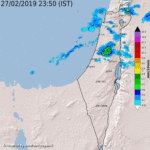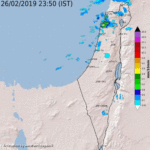Hi,
134 mm was the rainfall in Wednesday and Thursday this week. Of about 537 annual average rate fall, it is about a quarter. A quarter of what falls in three months in only three days!
It is more than all February average rainfall, in those numerous days.
And out of those three days, 112 mm fell in only 24 hours. The recored is about 121 from 17 of March 1916 (Thanks to 02WS my favorite forecast and weather site 😁). As much as a measurement from 1916 can be accurate…
Jerusalem mountains are not easily flooded. Unlike the Negev desert, which get flooded from its first drop of water. The soil in the Negev does not absorb water, leads that almost any rain leads to floods.
But the amount of water on those days are not the only thing that leads to floods. The fact that the days before were rainy left the water soaked. Means it cannot absorb any more rain. Any rain drop that fell started flowing. Add this to the amount of rain in this short period and you have floods in Jerusalem mountains 😃.
One of the biggest stream in Jerusalem mountains is Sorek stream, which got flooded. Beit Zait dam sits on Sorek and gathers the water and let it percolate (where the water goes is a different issue…). With those floods the dam overflowed. Some nice winter it is…
Take care
Gad
The flow during the rainfall even in Sorek stream under Moza bridge, and to overflow of Beit Zait Dam
Dolvim stream flows in Horseshoe junction. The stream gather the water Ramallah (North of Jerusalem).
First wave of flood – Hever stream waterfall on Judean Desert (East of Jerusalem).
The Rain radar on 27-28.02.2019 (source: weather2day.co.il)



